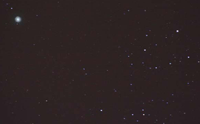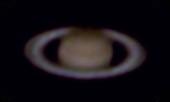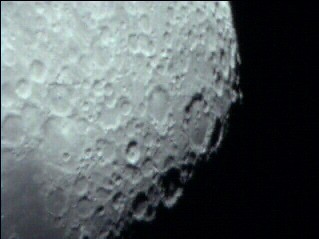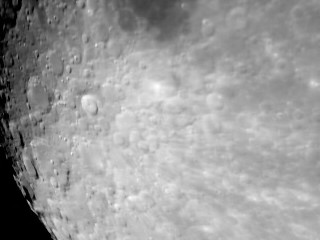Tasmin's Astronomy Page
Introduction
My childhood interest in Astronomy was
re-kindled in October 2003 when I peeked through a friend's telescope during the
2003 Mars opposition. That was the first-ever time I looked through a real
telescope. Allowing myself to be overcome with the "fever", I bought my first
ever telescope, a 6-inch Orion Deep Space Explorer (a dobsonian), and now I am
on my way to becoming a true deep-space astronomer, wife and funds permitting.
Equipment
- Telescope: 6" Orion DSE (dobsonian)
- Eyepieces: 26mm & 10mm plossls, 17mm Highlight plossl, and a 2x Orion Ultima Barlow
- Planetary filter set (6 piece, Celestron)
- Crude home-made setting circles
- Logitech QuickCam Pro (only lense removed so far,
long exposure modifications to circuit board are still pending.)
- Canon Powershot A95
- Canon Digital Rebel XT
Sofware
- AstroInfo PalmPilot application (I use with setting circles)
- Cartes du Ciel sky chart program
- K3CCD image aquisition software to use with web cam
- RegiStax image processing and stacking software
- Adobe Photoshop
- SkyView Cafe - a neato web based Java app
Astro-Photography results
The first two images (last two in list below) were taken with an Intel PC Camera
after removing the lense. The cameara was held in hand at the focuser. There was a
lot of shaking, but I managed to get some clear shots. Unfortunately this camera
was borrowed from my home PC setup that my family uses, so I had to return the
nice camera.
The later images were takes using an old logitech QuickCam Pro I got from
e-bay, and mercilessly hacked it to remove the lense and IR filter. I found
that the CCD was too far back inside the casing, and the focal point of my
telescope didn't reach it. So I removed the casing, made a hole in the
cap of a 35mm film canister, cut off the bottom of the canister, and
stuck the empty lense holder of the web cam into the hole I made in
the 35mm canister cap. Attaching the canister to the cap made it fit
the focuser and brought the CCD to the focal point of the telescope.
And more images were taken with Canon Powershot A95, and with Canon digital Rebel XT.
All telescope images were taken untracked, with a dobsonian mount. The images were captured
using K3CCD sofware while they drifted in the field of view. The telescope had to be
manually moved after every set of exposures, and the target re-found
before capturing the next set of images. The resulting avi's were
aligned, stacked, optimized, etc, and some image processing was done
-- all with RegiStax software. Further enhhancements were done in Adobe Photoshop
6.0, mostly iterative levels and curves, some hue/saturation, and color
balancing.
The Results
 |
| 14-Dec-07 |
Mars |
102 of 299 images stacked in RegiStax v4.0, processed in Photoshop.
Distance to Mars: 0.59118AU |
| |
 |
| 30-Oct-07 |
Comet 17P / Holmes |
Wide field captured with Canon Digital Rebel XT |
| |
 |
| 03-Nov-05 |
Mars |
74 frames stacked in RegiStax 3, processed in Photoshop.
Distance to Mars: 0.46595AU |
| |

Click to enlarge |
| 28-OCT-05 |
Mars and Pleiades |
Wide-field long exposure with Canon PowerShot A95 on tripod. 15 sec exposure with 16mm @ F/4, ISO400;
4 images registered, stacked and processed in Photoshop |
| |

Click to enlarge |

Click to enlarge |
|
| 23-Apr-04 |
Moon and Planets |
Wide-field long-exposure photographs with Canon EOS Rebel and 50mm lense. |
 |
| 28-Mar-04 |
Jupiter |
Used Logitech QuickCam Pro; stacked 12 or so images using RegiStax, and improved the
image by using wavelet filter, contrast, etc.
I timed the imaging session with the transition of the Red Spot, which you can
see here in the center, top half of the planet. |
| |
 |
| 28-Mar-04 |
Jupiter |
Brightness and contrast adjusted in previous image to bring out the satellites (moons)
of Jupiter. |
| |
 |
| 28-Mar-04 |
Jupiter |
Imaged with a 2x Barlow lense attached to Logitech QuickCam Pro; stacked 12 or so
images using RegiStax, and improved the image by using wavelet filter, contrast, etc. |
| |
 |
| 28-Mar-04 |
Jupiter |
Brightness and contrast adjusted in previous image to bring out the satellites (moons)
of Jupiter. |
| |
 |
| 12-Jan-04 |
Saturn |
Used Logitech QuickCam Pro; stacked 64 images using RegiStax, and improved the
image by using wavelet filter, contrast, etc. Then flipped, rotated, and
enlarged the image. |
| |
 |
| 2-Dec-03 |
Almaak - double star |
Test with Logitech QuickCam Pro with lense and casing removed. No
long-exposure modifications made yet!!! |
| |
 |
| 2-Dec-03 |
Da Moon |
Test with Logitech QuickCam Pro with lense and casing removed. |
| |
 |
| 7-Nov-03 |
Da Moon |
Another quick test using Intel PC Camera. |
| |
 |
| 7-Nov-03 |
Da Moon |
Quick test using Intel PC Camera with lense removed. The WebCam was held
in hand at the focuser.
|
| |
Ramblings
Having tried my luck at some deep-space
objects, I added crude setting circles to the dobsonian, and increased my
success rate tremendously. I use the setting circles with AstroInfo astronomy
software on my palm pilot. I also made my own list of deep-space objects for it,
that are observable from ligh-polluted areas, like the city I live in. My list
is customized to my latitude and gives me a sky tour without too-wide a jump
between objects, as is sometimes the case when you go through a list in
right-ascension order. My list also has major stars before each new group of
objects, so I can re-align my crude setting circles, and alleviate errors when
the movement would be too large.
I have also developed a web-based sky tour charts program. The charts have
telrad circles and my eyepiece fields of view superimposed on them. They
follow the same deep-sky objects' list as in my palm pilot,
but do not have the major stars in it, which are in the palm pilot
list for aligning the setting circles only. I was able to find some difficult
objects using my sky-tour charts program.
Most recently I acquired an old web cam (a logitech QuickCam pro),
mercilessly hacked it to remove the lense and IR filter, and removed it
from its casing to bring the CCD of the web cam to the focal point of the
telescope. The results of the webcam astro-photography are shown
above.
I still need to hack the web cam circuit board to remove the shutter trigger
and vertical transfer pulse, so I can do real deep-sky astro-photography.
But I suspect I will need to add tracking feature to my telescope,
otherwise the objects might drift across the CCD too fast for the prolonged
exposure to have any effect. We shall see...
I have also designed and partially started construction of a
fork-mount base. Please wish me luck and pray that I get it working
successfully, and without causing family problems ;-). If it works right,
I'll then think of adding the single axis tracking feature to it, so the
web cam may work better.
E-mail: tasminahmad at yahoo.com
Back to Tasmin's home page